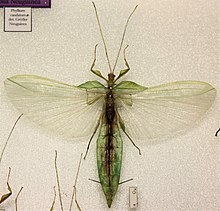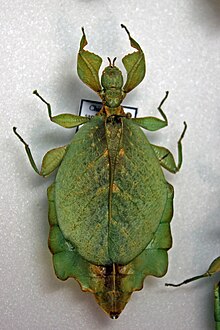en
names in breadcrumbs


The family Phylliidae (often misspelled Phyllidae) contains the extant true leaf insects or walking leaves, which include some of the most remarkably camouflaged leaf mimics (mimesis) in the entire animal kingdom. They occur from South Asia through Southeast Asia to Australia. Earlier sources treat Phylliidae as a much larger taxon, containing genera in what are presently considered to be several different families.[1]
Leaf insects are well camouflaged, taking on the appearance of leaves. They do this so accurately that predators often are not able to distinguish them from real leaves. In some species, the edge of the leaf insect's body has the appearance of bite marks. To further confuse predators, when the leaf insect walks, it rocks back and forth, mimicking a real leaf being blown by the wind.[2]

The scholar Antonio Pigafetta probably was the first Western person to document the creature, though it was known to people in the tropics for a long time. Sailing with Ferdinand Magellan's circumnavigational expedition, he studied and chronicled the fauna on the island of Cimbonbon as the fleet hauled ashore for repairs. During this time he documented the Phyllium species with the following passage:[3]
In this island are also found certain trees, the leaves of which, when they fall, are animated, and walk. They are like the leaves of the mulberry tree, but not so long; they have the leaf stalk short and pointed, and near the leaf stalk they have on each side two feet. If they are touched they escape, but if crushed they do not give out blood. I kept one for nine days in a box. When I opened it the leaf went round the box. I believe they live upon air.[4]
The subfamily Phylliinae has been divided into two tribes since 2003. This classification is not confirmed by more recent molecular genetics investigations. In addition to the fossil genus Eophyllium, the subfamily distinguishes thirteen recent genera, eight of which have been described since 2017.[5] Within the genus Phyllium, the subgenus Pulchriphyllium, set up by Achille Griffini in 1898, has been distinguished from Phyllium since 1898.[6][7] With Comptaphyllium and Walaphyllium two more subgenera became in 2019 and 2020.[8][9] As of 2021, all three subgenera are considered separate genera.[10]
Since 2021, in addition to morphological, molecular genetic studies have also increasingly been included in clarification of the phylogeny of Phylliidae. Their results show the general relationship between the genera, but when comparing female and male representatives, they do not yet provide a clear phylogenetic picture of the recent genera.[11]
Cladograms of the Phylliidae species determined on the basis of molecular genetics analysis and morphological investigations according to Cumming and Le Tirant (2022):[11]
Cladogram of Phylliidae ♀ Phylliidae Relationships of the Phylliidae genera after examining females from 27 species[11] Cladogram of Phylliidae ♂ Phylliidae Relationships of the Phylliidae genera after examining males from 28 species[11]The Phasmida Species File (V. 5.0) lists the following genera in two tribes:[12]
Auth. Brunner von Wattenwyl, 1893



Auth. Zompro & Grösser, 2003
Several species have gained in popularity as pets including Cryptophyllium celebicum, Cryptophyllium westwoodii, Phyllium jacobsoni, Phyllium ericoriai, Phyllium siccifolium, Phyllium letiranti, Phyllium monteithi, Phyllium philippinicum , Phyllium rubrum, Phyllium tobeloense, Pulchriphyllium bioculatum and Pulchriphyllium giganteum .
A 47-million-year-old fossil of Eophyllium messelensis, a prehistoric ancestor of Phylliidae, displays many of the same characteristics of modern leaf insects, indicating that this family has changed little over time.[13]
The family Phylliidae (often misspelled Phyllidae) contains the extant true leaf insects or walking leaves, which include some of the most remarkably camouflaged leaf mimics (mimesis) in the entire animal kingdom. They occur from South Asia through Southeast Asia to Australia. Earlier sources treat Phylliidae as a much larger taxon, containing genera in what are presently considered to be several different families.